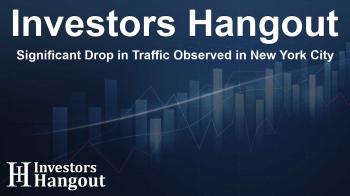Significant Drop in Traffic Observed in New York City

Significant Reduction in Traffic Following Congestion Fee
Recent reports indicate that traffic in New York City has seen a notable decrease since the introduction of the congestion pricing fee. Specifically, there was a 7.5% drop in traffic along with 273,000 fewer vehicles entering Manhattan's central business district.
The Impact of the Congestion Pricing Fee
The congestion fee, implemented for the first time in the United States, charges passenger vehicles $9 during peak hours when entering Manhattan south of 60th Street. The primary objective of this pricing structure is to alleviate congestion and enhance the flow of traffic within the city.
Feedback from Public Officials and Citizens
Transit officials have noted that the early data supports what many residents have been expressing regarding the city’s traffic situation. Janno Lieber, the head of the Metropolitan Transportation Authority, commented on the positive results, stating, "The streets feel safer, and buses are moving faster," which aligns with the goal of improving public transport efficiency.
Future Prospects for Congestion Pricing
As the city continues to analyze the effects of this congestion charge, there is hope that it will not only reduce traffic congestion but also encourage the use of public transport options. The decrease in vehicular traffic indicates a potential shift in driver behavior, which could lead to long-term changes in commuting patterns.
Advantages Beyond Reduced Traffic
With fewer cars on the road, the benefits extend beyond just reduced congestion. The safety of pedestrians and cyclists can be significantly enhanced when traffic is managed effectively. Moreover, this initiative aims to improve air quality by lowering emissions associated with heavy vehicle traffic.
The Broader Implications of Traffic Changes in Urban Areas
This congestion pricing model may serve as a blueprint for other urban areas facing similar challenges with traffic management. As cities become increasingly populated, innovative strategies like these are essential for maintaining a functional transportation infrastructure that can cater to the needs of their residents.
Frequently Asked Questions
What is congestion pricing?
Congestion pricing is a traffic management strategy that charges vehicles a fee to enter congested areas during peak times to reduce traffic volume.
How much is the congestion fee in New York City?
The congestion fee for entering Manhattan south of 60th Street is set at $9 during peak hours.
What were the traffic changes observed after implementation?
Following the implementation of the congestion fee, traffic in New York City reportedly fell by 7.5%, resulting in significantly fewer vehicles in the central business district.
What benefits does congestion pricing provide?
Congestion pricing can lead to improved traffic flow, enhanced public transport efficiency, increased pedestrian safety, and better air quality in urban environments.
Can other cities implement similar congestion pricing models?
Yes, cities across the world are exploring or have implemented similar models to manage urban traffic and encourage the use of public transportation.
About Investors Hangout
Investors Hangout is a leading online stock forum for financial discussion and learning, offering a wide range of free tools and resources. It draws in traders of all levels, who exchange market knowledge, investigate trading tactics, and keep an eye on industry developments in real time. Featuring financial articles, stock message boards, quotes, charts, company profiles, and live news updates. Through cooperative learning and a wealth of informational resources, it helps users from novices creating their first portfolios to experts honing their techniques. Join Investors Hangout today: https://investorshangout.com/
Disclaimer: The content of this article is solely for general informational purposes only; it does not represent legal, financial, or investment advice. Investors Hangout does not offer financial advice; the author is not a licensed financial advisor. Consult a qualified advisor before making any financial or investment decisions based on this article. The author's interpretation of publicly available data shapes the opinions presented here; as a result, they should not be taken as advice to purchase, sell, or hold any securities mentioned or any other investments. The author does not guarantee the accuracy, completeness, or timeliness of any material, providing it "as is." Information and market conditions may change; past performance is not indicative of future outcomes. If any of the material offered here is inaccurate, please contact us for corrections.
